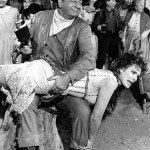To Train Up A Child, introduction
You probably know that I’ve been writing a page-by-page review of Debi Pearl’s manual on how to be a good wife, Created To Be His Help Meet. I’ve decided to begin doing the same for Michael and Debi Pearl’s child training manual, To Train Up A Child. Because the text is available online, I’m going to quote the entire thing over the course of this series rather than just excerpts. The end product will be the text of To Train Up A Child, with my commentary. I will be posting a new excerpt each Monday.
There’s a reason I’m doing this and there’s a reason I’m doing it now. There’s a lot of discussion about TTUAC, but there’s often a breakdown regarding what’s actually in the book. Defenders of the Pearls claim that detractors omit all of the good things contained in it, focusing instead on taking paragraphs out of context. At the same time, detractors themselves are often unclear on what is actually in the text themselves—and that is where you get news reports claiming, at the Hana Williams trial, that TTUAC tells parents to punish their children by shutting them outside in cold weather (something I’m pretty sure isn’t in the book). It is my hope that going over the book will help make clear what’s there and what’s not—and just how toxic this text is. And, as you may expect, I’ll be sharing some positive parenting tips and suggestions and contrasting them with what the Pearls advise.
Before we dip into the book’s introduction, a little introduction to the Pearls is in order. Michael and Debi Pearl run No Greater Joy Ministries. They have a large following in the evangelical and fundamentalist homeschool community, and are most well known for To Train Up A Child and Created To Be His Help Meet. Both books have been translated into numerous languages and have sold hundreds of thousands of copies worldwide. Three different children have died of child abuse in families that followed the Pearls’ child training methods, but the Pearls have not retracted any of their teachings.
Now on to the book’s introduction:
INTRODUCTION
This book is not about discipline, nor problem children. The emphasis is on the training of a child before the need to discipline arises. It is apparent that most parents never attempt to train a child to obey. They wait until the child becomes unbearable and then explode. With proper training, discipline can be reduced to 5% of what many now practice. As you come to understand the difference between training and discipline, you will have a renewed vision for your family—no more raised voices, no contention, no bad attitudes, fewer spankings, a cheerful atmosphere in the home, and total obedience from your children.
One way that the Pearls make parents more likely to accept the teachings of their book—and head off criticism that they are promoting abuse—is by continually denouncing yelling and out of control physical punishment (which is good) and continually speaking of creating home environments where children are cheerful and parents and children have a loving and tender connection (which is also good). Another thing the Pearls do is to differentiate between discipline and training, suggesting that discipline is punishing your kids for disobedience and rebellion while training heads off discipline and rebellion entirely (a promise that proves especially attractive to evangelical and fundamentalist parents). When taken together, these ideas help make the Pearls’ book deceptively attractive to parents, and especially to parents who may have been pointed to the book by a trusted friend.
But the problem is already visible, even in this very first paragraph of the book. What is the Pearls’ goal? To help raise healthy, compassionate, and well-adjusted children who will be able to make a positive transition to adulthood? No. They promise “a renewed vision for your family” in which, in addition to less yelling and spanking, parents will have “total obedience” from their children. That—total obedience—is the goal here. And that’s not healthy.
Any parent with an emotional maturity level higher than the average thirteen-year-old can, with a proper vision and knowledge of the technique, have happy obedient children. This is not a theory; it is a practical reality which has been successfully applied many times over.
A couple, stressed out with the conflict of three young children, after spending the weekend with us and hearing some of these principles, changed their strategy. One week later, they exclaimed, “I can’t believe it; we went to a friend’s house, and when I told my children to do something, they immediately, without question, obeyed.”
Again, what is the goal? Obedience. Not ethical or resilient or self-activated children—obedient children.
These truths are not new, deep insights from the professional world of research, rather, the same principles the Amish use to train their stubborn mules, the same technique God uses to train his children. They are profoundly simple and extremely obvious. After examining them with us, you will say, “I knew that all along. Where have I been? It’s so obvious.”
Throughout this book, the Pearls claim that the same principles the Amish use to train mules should be applied to training children. In fact, Michael has often referred to watching the Amish train their mules as the inspiration for his ideas about child training. I know nothing about how the Amish train their mules, or about how mules are trained outside of Amish circles, but regardless of whether the Pearls have the whole mule-training thing right (something I highly doubt), children are not mules. For one thing, children are supposed to grow up into functioning adults while mules remain, well, mules. What are children? Children are miniature people who need care, love, and preparation for the adult world. Not in the Pearls’ world, though. In the Pearls’ world, children, like mules, need only be trained for complete and total unquestioning obedience.














